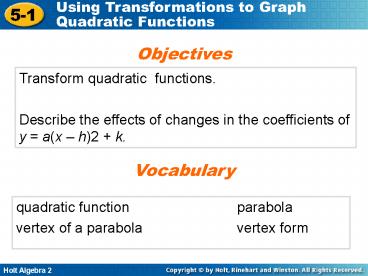Transform quadratic functions. - PowerPoint PPT Presentation
1 / 17
Title:
Transform quadratic functions.
Description:
Objectives Transform quadratic functions. Describe the effects of changes in the coefficients of y = a(x h)2 + k. Vocabulary quadratic function parabola – PowerPoint PPT presentation
Number of Views:147
Avg rating:3.0/5.0
Title: Transform quadratic functions.
1
Objectives
Transform quadratic functions. Describe the
effects of changes in the coefficients of y a(x
h)2 k.
Vocabulary
quadratic function parabola vertex of a
parabola vertex form
2
Notes 1-3
1. Use the graph of f(x) x2 as a guide, describe
the transformations and then graph each function.
g(x) (x 3)2 2
2. Using the graph of f(x) x2 as a guide,
describe the transformations and then graph each
function
g(x) ½ x2
3. The parent function f(x) x2 is stretched
by a factor of 3 and translated 4 units right and
2 units up to create g. Write g in vertex form.
3
In Chapters 2 and 3, you studied linear functions
of the form f(x) mx b. A quadratic function
is a function that can be written in the form of
f(x) a (x h)2 k (a ? 0). In a quadratic
function, the variable is always squared. The
table shows the linear and quadratic parent
functions.
4
Notice that the graph of the parent function f(x)
x2 is a U-shaped curve called a parabola. As
with other functions, you can graph a quadratic
function by plotting points with coordinates that
make the equation true.
5
If a parabola opens upward, it has a lowest
point. If a parabola opens downward, it has a
highest point. This lowest or highest point is
the vertex of the parabola.
The parent function f(x) x2 has its vertex at
the origin. You can identify the vertex of other
quadratic functions by analyzing the function in
vertex form. The vertex form of a quadratic
function is f(x) a(x h)2 k, where a, h, and
k are constants.
6
Because the vertex is translated h horizontal
units and k vertical from the origin, the vertex
of the parabola is at (h, k).
7
Example 1A Translating Quadratic Functions
Use the graph of f(x) x2 as a guide, describe
the transformations and then graph each function.
g(x) (x 2)2 4
Identify h and k.
g(x) (x 2)2 4
Because h 2, the graph is translated 2 units
right. Because k 4, the graph is translated 4
units up. Therefore, g is f translated 2 units
right and 4 units up.
8
Example 1B Translating Quadratic Functions
Use the graph of f(x) x2 as a guide, describe
the transformations and then graph each function.
g(x) (x 2)2 3
Identify h and k.
g(x) (x (2))2 (3)
Because h 2, the graph is translated 2 units
left. Because k 3, the graph is translated 3
units down. Therefore, g is f translated 2 units
left and 4 units down.
9
Example 1C
Using the graph of f(x) x2 as a guide, describe
the transformations and then graph each function.
g(x) x2 5
Identify h and k.
g(x) x2 5
Because h 0, the graph is not translated
horizontally. Because k 5, the graph is
translated 5 units down. Therefore, g is f is
translated 5 units down.
10
NOTES 1
Use the graph of f(x) x2 as a guide, describe
the transformations and then graph each function.
g(x) (x 3)2 2
Identify h and k.
g(x) (x (3)) 2 (2)
Because h 3, the graph is translated 3 units
left. Because k 2, the graph is translated 2
units down. Therefore, g is f translated 3 units
left and 2 units down.
11
Recall that functions can also be reflected,
stretched, or compressed.
12
(No Transcript)
13
Example 2A Reflecting, Stretching, and
Compressing Quadratic Functions
Using the graph of f(x) x2 as a guide, describe
the transformations and then graph each function.
1
(
)
-
2
g x
x
4
Because a is negative, g is a reflection of f
across the x-axis.
14
Notes 2
Using the graph of f(x) x2 as a guide, describe
the transformations and then graph each function.
Because a is negative, g is a reflection of f
across the x-axis.
15
Example 3 Writing Transformed Quadratics
Use the description to write the quadratic
function in vertex form.
Step 1 Identify how each transformation affects
the constant in vertex form.
Translation 2 units right h 2
Translation 4 units down k 4
16
Example 3 Continued
Step 2 Write the transformed function.
g(x) a(x h)2 k
Vertex form of a quadratic function
Simplify.
17
Notes 3
The parent function f(x) x2 is stretched by
a factor of 3 and translated 4 units right and 2
units up to create g. Write g in vertex form.
g(x) 3(x 4)2 2































